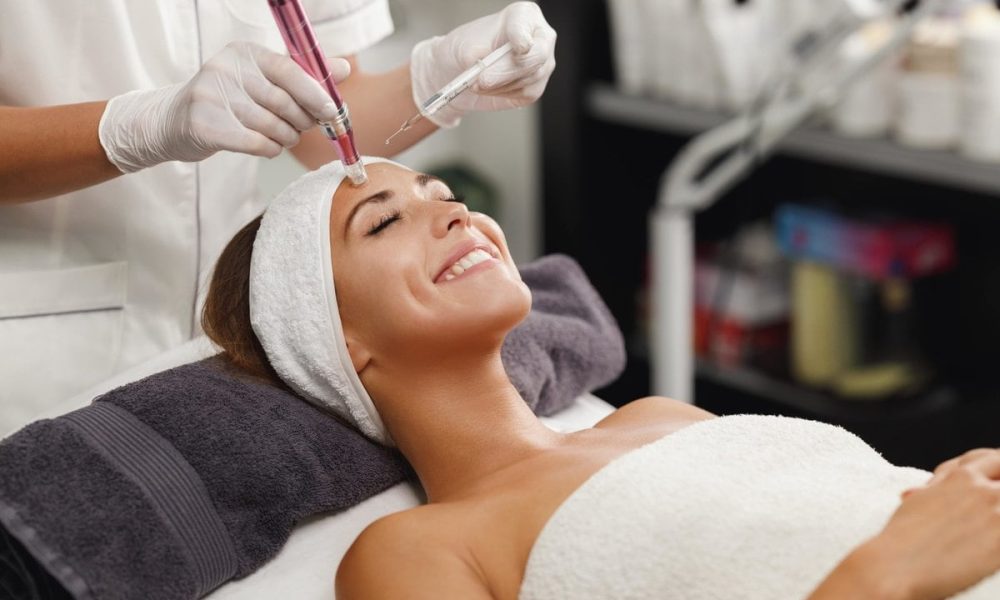Microneedling has revolutionized the skincare industry, offering a minimally invasive yet highly effective solution to rejuvenate the skin. By tapping into the body’s natural healing process, microneedling stimulates collagen and elastin production, helping individuals achieve a firmer, smoother, and more radiant complexion. Whether you’re looking to reduce scars, improve texture, or restore a youthful glow, this cutting-edge treatment is safe, versatile, and suitable for all skin types.
In this blog, we’ll explore the science behind microneedling, its numerous benefits, and who can benefit most from this innovative skincare treatment.
What Is Microneedling?
Microneedling, also known as collagen induction therapy, is a non-surgical procedure that uses fine needles to create microchannels in the skin’s surface. These controlled micro-injuries stimulate the body’s natural healing response, leading to increased collagen and elastin production—two essential proteins responsible for skin elasticity, firmness, and overall health.
This treatment not only rejuvenates the skin but also enhances the absorption of skincare products, allowing serums and topical treatments to penetrate deeper layers for maximum efficacy.
The Science Behind Microneedling
The effectiveness of microneedling lies in its ability to trigger the body’s natural repair mechanisms. Here’s how it works:
- Creating Microchannels: The fine needles puncture the skin’s surface at a controlled depth, creating micro-injuries that are not visible to the naked eye.
- Stimulating Collagen and Elastin Production: The body perceives these micro-injuries as damage and activates its healing process. This involves the production of collagen and elastin, which help restore the skin’s structure and resilience.
- Enhanced Cell Turnover: The process encourages the shedding of dead skin cells and the regeneration of new, healthy skin cells, leading to a brighter and more even complexion.
- Boosting Product Absorption: The microchannels allow for deeper penetration of active ingredients in serums and treatments, amplifying their benefits.
Benefits of Microneedling
Microneedling offers a wide array of benefits, making it a popular choice for those seeking to improve their skin’s health and appearance.
1. Stimulates Collagen and Elastin Production
The increase in collagen and elastin improves skin texture, firmness, and elasticity, reducing the appearance of fine lines and wrinkles.
2. Reduces Scarring
Microneedling is highly effective in treating various types of scars, including:
- Acne scars: Smooths and softens uneven skin caused by past breakouts.
- Surgical scars: Improves the texture and appearance of scars from medical procedures.
- Stretch marks: Minimizes the visibility of stretch marks on the skin.
3. Refines Skin Tone and Texture
Microneedling addresses hyperpigmentation, sun damage, and uneven texture, leaving the skin brighter and more even-toned.
4. Minimizes Pores
By stimulating collagen around pore walls, microneedling helps reduce the appearance of enlarged pores.
5. Enhances Skincare Efficacy
The microchannels created during treatment allow skincare products to penetrate deeper layers of the skin, boosting their effectiveness.
6. Non-Invasive with Minimal Downtime
Microneedling is a minimally invasive procedure with little to no downtime. Most individuals can return to their daily routines shortly after treatment.
Who Is a Good Candidate for Microneedling?
Microneedling is suitable for a wide range of individuals and skin concerns. Ideal candidates include those who want to:
- Reduce fine lines and wrinkles.
- Improve the appearance of acne scars or surgical scars.
- Refine skin tone and texture.
- Minimize pores and improve skin elasticity.
- Rejuvenate dull, tired-looking skin.
Who Should Avoid Microneedling?
While microneedling is safe for most people, certain conditions may make the treatment unsuitable:
- Pregnancy or Breastfeeding: It is not recommended for pregnant or breastfeeding women.
- Active Skin Conditions: Individuals with active acne, cold sores, or skin infections should postpone treatment until their skin has healed.
- Recent Cosmetic Procedures: Those who have recently had fillers, Botox, or chemical peels should consult their provider about the appropriate waiting period.
- Medications: People on blood thinners or isotretinoin (Accutane) should consult their healthcare provider before undergoing microneedling.
What to Expect During Microneedling Treatment
1. Consultation
Your journey begins with a consultation to assess your skin concerns and goals. A personalized treatment plan is created to address your unique needs.
2. Preparation
Before the procedure, your skin is thoroughly cleansed, and a topical numbing cream is applied to ensure maximum comfort.
3. Treatment
A specialized device with fine needles creates microchannels in the skin’s surface. The treatment typically takes 30-60 minutes, depending on the size of the area being treated.
4. Post-Treatment Care
After the procedure, soothing serums are applied to aid the healing process. You may experience mild redness or sensitivity, which subsides within a day or two.
5. Results
You’ll start noticing results within a few days, with continued improvements over the following weeks as collagen production increases.
Microneedling Success Stories
Clinical studies and user testimonials consistently highlight the effectiveness of microneedling:
- 85% of individuals report a noticeable reduction in fine lines and wrinkles.
- 90% see significant improvement in acne scars and hyperpigmentation.
- 92% experience smoother, more even skin texture.
- 87% notice firmer, tighter skin within weeks of treatment.
Why Microneedling Is a Safe Choice
Microneedling is designed to be both safe and effective for all skin types. Its minimally invasive nature and customizable depth make it a versatile treatment with minimal risks. When performed by trained professionals, microneedling delivers transformative results without the complications associated with more invasive procedures.
Frequently Asked Questions About Microneedling
1. Is Microneedling Painful?
A topical numbing cream is applied before the treatment to minimize discomfort. Most people find the procedure tolerable, with only mild tingling sensations.
2. How Many Sessions Will I Need?
The number of sessions depends on your specific skin concerns. While some individuals see results after one treatment, a series of 3-6 sessions is often recommended for optimal results.
3. How Long Do Results Last?
With proper skincare maintenance, the results of microneedling can last for several months. Regular follow-up treatments can extend the benefits.
4. Is There Downtime?
Microneedling has minimal downtime. You may experience slight redness or sensitivity for a day or two but can resume normal activities shortly after.
Unlock Your Skin’s Potential
Microneedling is a proven, science-backed solution for achieving healthier, more youthful skin. Its ability to address a wide range of skin concerns—while remaining safe and minimally invasive—makes it an ideal choice for anyone looking to rejuvenate their complexion.
Ready to transform your skin? Schedule a consultation today to learn how microneedling can help you achieve your skincare goals. Take the first step toward a radiant, confident you!


